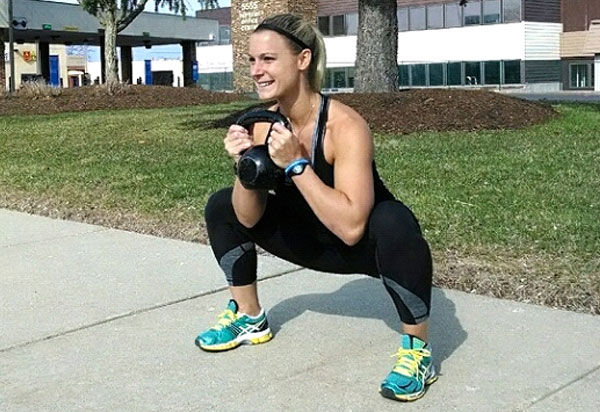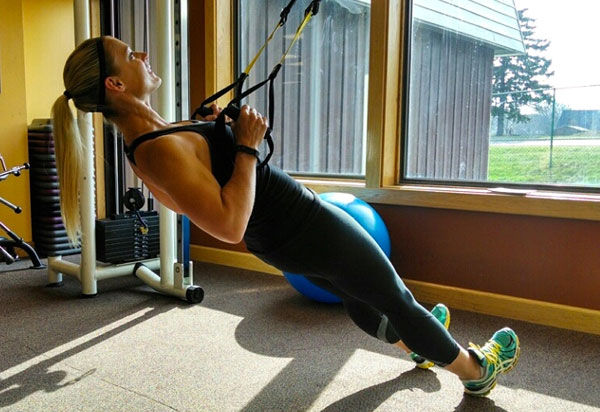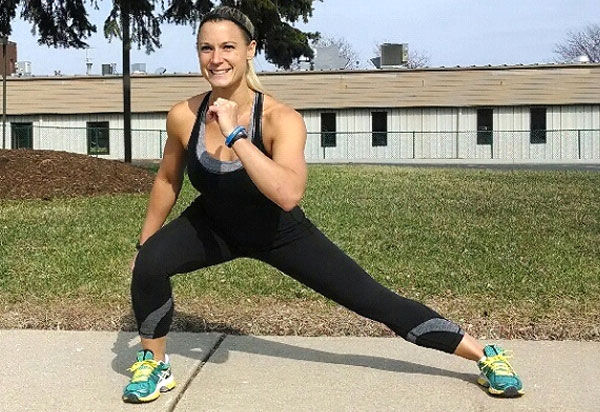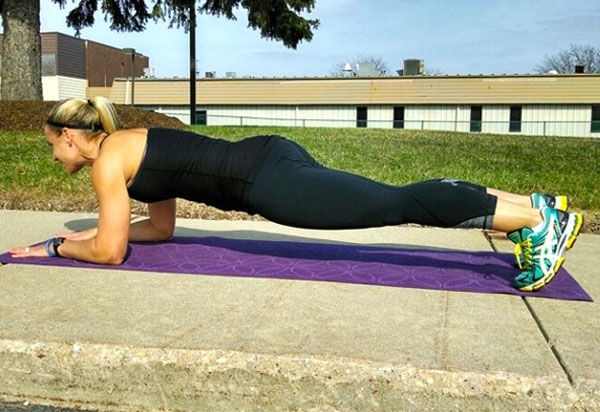It’s summertime and many people are taking advantage of the warm weather by running outdoors. What many runners don’t know, however, is that strength training is important in improving alignment and efficiency, as well as stabilizing the joints used while running. If running is part of your workout regimen, here are some strength training exercises that will help you become a better runner and keep you injury free!
Kettlebell Goblet Squats

Runners need to use their glutes instead of being hamstring dominant. By lowering down into a deeper squat, the glutes play a much bigger role and hip mobility is improved.
Hold a kettlebell by the horns (or a dumbbell vertically by one end) against your chest. Feet should be a little wider than shoulder-width apart and toes turned out slightly (the less mobile the hips, the more the toes will need to turn out). Drop the hips straight down to the floor with the chest open and shoulders anchored down and back. Pretend you are separating the floor with your feet and engage your glutes as you power back up to the starting position.
Tips: This can also be done as a body-weight squat or as an assisted squat with the TRX suspension trainer. Squatting this deep is not for everybody, so if you have any contraindications to this exercise, remove the load to ensure your range of motion is pain free.
TRX Row

Proper poster is important in preventing injury and improving arm drive. With every step a runner takes the shoulders are briefly pulled forward into a kyphotic (hunched) posture. With improved upper-back strength, a runner can help combat this and stand tall!
Fully shorten your TRX Suspension Trainer and stand facing the anchor point. Keep the body perfectly planked as you walk under to an angle that is safe, yet challenging. Begin the row by retracting and depressing your shoulder blades and then follow through by pulling your body to your wrists, never losing your plank.
Tips: This exercise can also be done under a Smith machine bar at varied heights. Your form will break is the angle is too steep and do not let the back round or arch while doing the movement.
Walking Lateral Lunges

Runners spend a lot of time moving in one direction: forward. Thus it is important to strengthen and stabilize the hips and muscles around the knees by moving sideways!
Step to the left with the left toe pointed directly forward, allowing the left hip to drop down and back. By bracing that hip and keeping the right leg straight, step the right leg in and repeat.
Tips: Standing lateral lunges with a wide stance and shifting weight from side to side is a lower-intensity option. During the movement, make sure the knee tracks over the foot (not buckling in or out) and that the back stays flat with the chest up and open.
Single Leg Romanian Deadlifts

This exercise helps improve balance, core strength through resisting rotation, bilateral imbalances and hip mobility, and strengthens the glutes and hamstrings.
Begin by holding a dumbbell in the opposite hand of the planted foot. Keep a neutral spine and only a slight bend in the planted leg as you hinge forward, keeping square with the ground. Once the end range of a flat torso is reached (your body should form a capital T if you have the mobility) lower that leg back to the ground.
Tips: If you are struggling with perfect form, ditch the weight and first master the hip hinge. Care should be taken to ensure a neutral spine throughout the entire movement. Forward flexion will not only take away from the exercise, but will also put excessive strain on the lumbar spine.
Planks

To stabilize your back and body, and to appropriately transfer power, core strength is key for runners.
With the forearms on the ground and elbows directly under the shoulders, brace every muscle of your body (especially those glutes!) and hold a perfectly straight line for 10 seconds on, two seconds off, for four sets. Shorter, tighter planks will lead to better strength gains.
Tips: If you cannot complete a 10-second plank without the hips sagging, move your knees to the ground. If you want to progress your plank, check out this article by Jonathan Ross.
There are many wonderful exercises for runners and variety is key! If running is a regular part of your fitness routine, I highly recommend scheduling an appointment with an ACE Certified Personal Trainer to discuss resistance training options.




 by
by 



 by
by